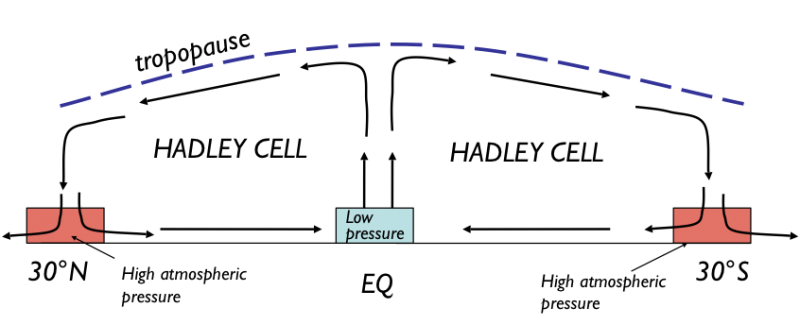
Due to the Earth’s curvature and its 23.5° axial tilt, the Sun’s energy only strikes the Earth’s surface head-on at a specific point, called the subsolar point. At this location, the sun is directly overhead and the very intense rays of sunlight hit the Earth exactly perpendicular to its surface, resulting in an atmospheric effect known as the Hadley Cell (https://en.wikipedia.org/wiki/Hadley_cell).
The Hadley Cell is a pattern of atmospheric circulation that occurs about 20 to 35° in latitude north and south of the equator, in and around the subsolar point. The mechanism of this global phenomenon is quite complex, resulting in several widespread effects such as wind flow, regional temperature effects, and the overall latitudinal climate. Here’s how it works:
- Intense solar heating at the equator via the subsolar point result in high temperatures causing the air to rise as it warms.
- As the heated air rises, it expands and cools as it reaches higher altitudes, forming large fluffy cumulus clouds that yield heavy precipitation in the region (tropical latitudes) and leaving lower pressures at the surface.
- Air ascends high enough to reach the lowest layer of Earth’s atmosphere. At this altitude, the air has now significantly cooled and begins to descend back to the Earth’s surface between 30° north and south latitude, moving towards the poles.
- As the air descends, it begins to heat up once again. Descending air also bring descending high pressure, so as the air reaches the surface, it is forced back towards the equator. This movement of air from areas of high pressure into low pressure creates trade winds, which have been used by sailing ships to travel the oceans for centuries. These patterns of air movement are occurring as the Earth rotates as well, thus, the winds created from this atmospheric circulation are directed westward above below the equator, due to the Coriolis effect (https://en.wikipedia.org/wiki/Coriolis_force).
These patterns of airflow are responsible for many different climate effects on the planet yet only exist due to one simple but impactful catalyst: sunlight. In latitudes under the influence of Hadley Cell circulation, you’ll find heavy precipitation and thunderstorms, subtropical deserts, rainforests, hurricanes, and jet streams.